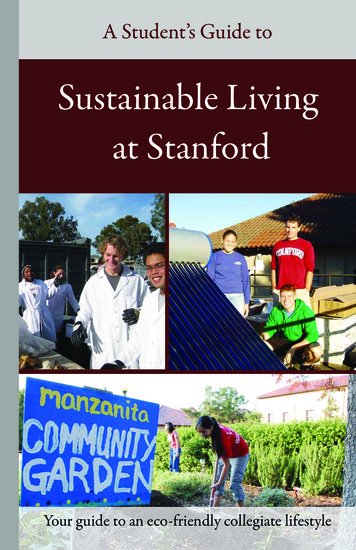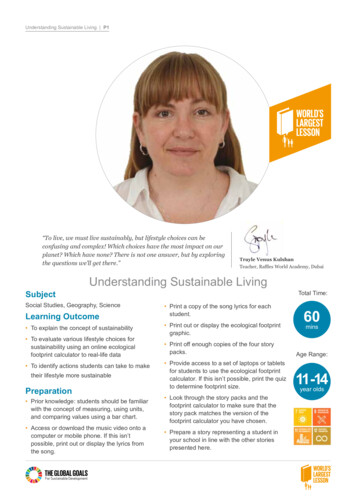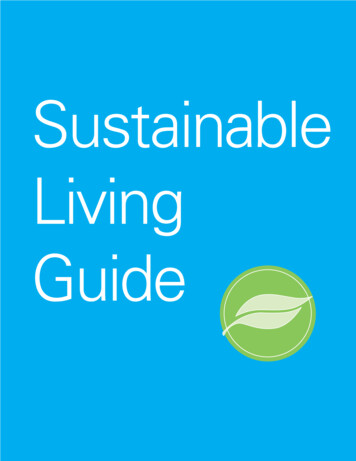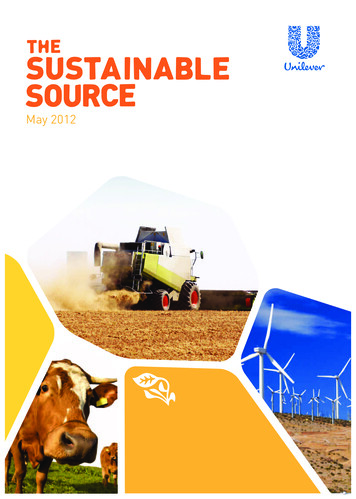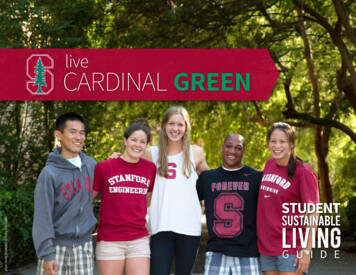
Transcription
photo credit: Residential & Dining EnterprisesliveCARDINAL GREENSTUDENTG U I D E
If we are to leave our children a better world, we must take stepsnow to create a sustainable environment. So it is critical that wemodel sustainable citizenship on our own campus.Persis DrellProvost, Stanford UniversityTABLE OF CONTENTSWelcome to Stanford!I’ll be your guide.Follow me to learn howto live Cardinal Green.Action Guide2In Your Room4In the Laundry Room & Bathroom6Managing Your Waste8Where You Eat10On the Street12In the Classroom14In White Plaza16On Stanford’s Campus18Increase Your Stanford Sustainability IQ19Sites to Visit20
Stanford is incorporatingsustainability practices intoevery aspect of campus life.L E T T E R FR OMSHIR L EY J. EVER ET T AN D FA H M I DA A H M E DWelcome to Stanford, where a sustainable campus reflects the university’s core values, values first articulated by Jane andLeland Stanford more than a century ago. On behalf of Residential and Dining Enterprises (R&DE) and the campus Office ofSustainability, we invite you to explore how to be Cardinal Green in your daily life as a Stanford student.We firmly believe that sustainability means responsibly meeting the needs of today so as to not compromise the ability tomeet the needs of future generations. Stanford incorporates sustainability practices into every aspect of campus life. Inaddition to having dramatically reduced its carbon footprint, the campus is working toward becoming 80% carbon neutralby 2025 and achieving zero waste by 2030, “defined as 90% diversion from the landfill or higher.” As we continue to seekinnovative and lasting solutions, we need you, the most important campus stakeholder, to be an active part of that journey.Sustainably Yours, Shirley J. Everett, Ed.D.Fahmida AhmedSenior Associate Vice ProvostResidential & Dining EnterprisesDirectorSustainability and SEM Business ServicesLIVE CARDINAL GREENThis guide provides resources and simple tips for leading an eco-friendly lifestyle on campus. Whether in your new room, atthe dining hall, or out and around campus, there are multitudes of opportunities to take simple actions that can add up toa significant reduction in our collective footprint. Your choices and actions do matter. With your enthusiasm, support, andcreativity, we look forward to progressing toward a shared vision — a truly sustainable Stanford University, your home forthe next four momentous years.1
3 ACTION GUIDE In Your RoomRR Manage your plug loadwith energy efficientlights, smart power stripsand using shared printersand appliances instead ofhaving your own.RR Install “Big Fix” on yourcomputer.RR Use natural light duringthe day.RR Know how the heatingsystem works in yourroom.RR Have sustainable parties.SUSTAINABLE LIVING GUIDERR Use your multi-recyclerin your room to sort yourwaste before you get tothe waste enclosure.2CHALLENGEBe plug load free bynot having a personalrefrigerator, TV, spaceheater or other majorappliance or electronicsin your room.Laundry & BathroomManaging Your WasteRR Only wash full loads oflaundry to save time,energy, and water,and use only ¼ cup ofdetergent.RR Minimize your “stuff” oncampus.RR Wash your clothes incold water instead of hotwater.RR Share, donate, or sellwhat you no longer need.RR Air-dry or combine loadsin the dryer, and don’toverdry.RR Sort your waste forrecycling and composting.RR When attending events oncampus or getting food togo, try to bring your ownmug and utensils.RR Report leaks andmaintenance problems.RR Vote with your fork!Choose seasonal, local,organic, antibiotic-free,and unprocessed foodwhenever possible.RR Eat lower on the foodchain.healthier for youand the planet!RR Follow R&DE StanfordDining’s motto of “LoveFood, Hate Waste” by onlytaking what you’ll eat andcomposting the rest.RR Grow your food in anon-campus organicgarden or theeducational farm.RR Use your own hand towelin the bathroom.RR Take shorter showersand don’t let the sink runwhile you brush or shave.CHALLENGETime your showers toless than five minutes.Where You EatCHALLENGETry not having a trash(landfill) bin in your room.Set yourself up with arecycling and compostingbin system that followsStanford’s Zero WasteGuidelines on page 8.CHALLENGEFor the academic year,choose to eat no meaton Mondays.
On the StreetRR Ride your bike or walk.RR Take public transit, suchas buses or trains.RR Share a ride whentraveling locally andbeyond.RR Get a car or ride whenyou need it throughStanford’s car share,carpool and rent-a-carprograms.RR Be rewarded for asustainable commuteand for wearing a bikehelmet for every ride,even short trips.In the ClassroomIn White PlazaRR Consider taking oneof the many greatsustainability relatedcourses on campus.RR Join the CampusSustainability Communitythrough the My CardinalGreen portal.RR Check out the availableacademic majors oncampus that emphasizesustainability.RR Get real-world workingexperience by interningwith sustainabilityprofessional staff oncampus.RR Take advantage ofStanford’s passionatefaculty by gettinginvolved with meaningfulresearch opportunitieson campus.On Stanford’s CampusRR Increase your StanfordCampus Sustainability IQ: Where does Stanford’swater come from? What is SESI? What are two federallyprotected species onStanford’s land?RR Get involved with asustainability studentgroup and become astudent leader.Follow me to learn how to live more sustainably, and earnrewards for completing these actions and others customized toYOUR lifestyle throughCHALLENGEDon’t pay to bring yourown car to campus.You’ll find you won’tneed it!CHALLENGETake one of the manyintroductory courses offeredon sustainability and learnhow you can apply itsprinciples to your academicmajor and lifestyle.CHALLENGEGet involved in one ofover 10 sustainabilityrelated student groupson campus!CHALLENGEVisit all of thesustainable sitesaround theStanford campuson pages 20-21.LIVE CARDINAL GREENSign in now to begin at http://sustainable.stanford.edu/my-cardinal-green3
in your ROOMYour home, whether a dormroom, apartment, or house,is the easiest place to beginmaking a positive impact.Make it convenient to leada sustainable lifestyle bysetting your room up forsuccess.SUSTAINABLE LIVING GUIDECHALLENGE4Be plug load freeby not having apersonal refrigerator,TV, space heater,or other majorappliance orelectronics inyour room.FACT:Stanford’s “Big Fix” is a software tool thatmanages the power usage of your computer.Installing it on 24,000 campus computerswill save an estimated 400,000 per year, aswell as reduce campus carbon emissions by28,000 tons.Install “Big Fix” athttps://uit.stanford.edu/software/bigfixSAVEs 400,000/yearreduces28,000 tonsCARBON EMISSIONS
live CARDINAL GREENManage Your Plug Load.Sort your waste. Know how the heating system works in your room. Did you know the typicalred plastic party cup isnot recyclable and takes450YEARS TODECOMPOSE! Have sustainable parties. If you are serving snacks, try finger food to avoid the need forplates. Minimize use of disposables with reusable, recyclable, orcompostable serviceware, available for purchase in the Green Store.The typical red plastic party cup is not recyclable and takes 450 yearsto decompose! Make sure to have recycling, compost and landfillbins available for guests to use – and use good signage so they knowwhat goes in which bin. Learn more about green events on campus atsustainable.stanford.edu/green-eventsUse the multi-recyclers in yourroom to sort your landfill,paper, and plastics, metalsand glass separately. Heating and cooling account for more than half of the energy usagein the average U.S. home, so turn off your thermostat when youleave and consider turning it down when you’re there. If you arehaving trouble controlling your heat, contact your Housing BuildingManager.Clothing is the easiest way to moderate your thermal comfort. Dressappropriately for the season.If your room has a thermostat, set it to 68 during cold months.Close doors and windows when systems are running, regardless ofwhether you control them. If you are uncomfortable, report the needfor repairs instead of opening doors or windows, or purchasing aportable electric space heater.During winter months, open window coverings during the day, andclose them at night to absorb and retain the natural heat from thesun. On warmer days, keep them closed to keep your room coolerduring the day.TO LEARN MOREVisit Stanford’s R&DE Student Housing Sustainable Living IVE CARDINAL GREEN At least 22% of campus electricity use is associated with things youplug in. Try to use items available in common areas, such as TVs,fridges, and printers, before purchasing individual ones for yourroom. If after you arrive you find you need an appliance, considerrenting one so that it can easily have a new life after you leave, or ifyou must buy, purchase one with an ENERGY STAR logo and share itwith your roommates.Buy a smart power strip for the electronics you do plug in to managethem more efficiently.Use natural light during the day. If you find you need extra lighting inyour room, make sure to use LED bulbs. They last 20 times longer andsave 90% of the energy compared to incandescent.5
in the LAUNDRY ROOM and BATHROOMLess than 0.01% of theEarth’s water is availablefor human use. Changingjust a few little things inyour daily routine canmake a big difference inhow we use this invaluableresource during California’sdrought.SUSTAINABLE LIVING GUIDECHALLENGE6Time yourshowers to lessthan five minutes.FACT:The ENERGY STAR front-loading washers used throughoutR&DE Student Housing are among the most energyefficient machines available on the market, saving up to50% or more on energy, water, and sewer costs.You can save up toWECHALLENGEYOU TOREDUCEYOURSHOWERTIME!2 GALLONSOF WATERwithEACH MINUTEyou take offyour shower!
live CARDINAL GREENBathroomOnly wash full loads of laundry to save time,energy, and water, and use only ¼ cup of detergent. Laundry habits have a huge potential for energy and water savings,especially considering the over 800 washers and dryers availableacross R&DE Student Housing.Our High Efficiency (HE) front-loading washers only require ¼ cup ofHE detergents for a full load – if you use more, your clothing may notcome out as clean.9of0en%ergy hsato w esdesu hes goclot heatinginto watertheWash your clothes incold water instead ofhot water – it works justas well and will helpyour clothes last longer.A small faucet dripcan easily waste20 Running the dryer for an extra 15 minutes for a larger load still usesless energy and time than running a separate load. Make sure not tooverdry clothing or air-dry clothes instead, to make them last longerand save 100% of the energy.fixit.stanford.eduor by contacing yourHousing Front Desk.of water a day.Use your own hand towel in the bathroom. If all Americans used one less paper towel a day, over 570 pounds ofpaper would be spared over the course of the year.Take shorter showers and don’t let the sink run while youbrush or shave. Air-dry or combine loads in the dryer, and don’t overdry.GALLONSIf you see a leakyfaucet, toilet, shower,landscape sprinklers, or anyappliance or fixture thatisn’t functioning, let R&DEStudent Housing know ASAPby filing a Fix-It request at You can save up to two gallons of water with each minute you takeoff your shower.Turn off the water in the shower while shampooing or shaving.TO LEARN MOREVisit Stanford’s R&DE Student Housing Sustainable Living IVE CARDINAL GREENlaundry7
managing your WASTEStanford makes it easy torecycle or donate everythingthat you no longer need.But the idea of zero wastestarts with reducing yourown consumption.SUSTAINABLE LIVING GUIDECHALLENGE8Try not having a trash(landfill) bin in yourroom. Set yourselfup with a recyclingand composting binsystem that followsStanford’s ZeroWaste Guidelinesabove.FACT:In 2017, werecycled63%of our waste,only sent37%to the landfill.65%Of the 37% of wastethrown in the trash,65% could have beenreused, recycled orcomposted. Be sureto put your stuff inthe right bin!
live CARDINAL GREENMinimize your “stuff” on campus.Share, donate, or sell what you no longer need. Sort your waste for recycling and composting. Check out the zero waste guidelines to see how to sort your plastics,metal, glass, paper and cardboard into the appropriate es-labels-and-signageStanford’s composting program accepts ALL food, including meat,dairy, and plant-based products, as well as soiled paper and plasticslabeled “compostable.” Compost bins are located in all dining hallsand nearly all waste corrals in R&DE Student Housing.com posting/’kämpōst/Stanford students discard tons of valuable goods at the end of eachacademic year. Set aside your clothes, books, kitchen goods, andmiscellaneous room items to be donated through the R&DE StudentHousing Give & Go program that provides collection barrels nearevery residence. Throughout the year you can also donate at the PaloAlto Goodwill store, and the Stanford Recycling Center.Sell your unwanted items on SUpost.com, or Craigslist.Small e-waste, such as printer cartridges or dead cell phones, can bedropped off at most R&DE Student Housing front desks for recycling.Larger items, such as computers, TVs, and printers, can be brought toPSSI (Peninsula Sanitary) on campus at 339 Bonair for recycling.Over 2,000 students participated in R&DE Student Housing andSustainable Stanford’s Give & Go campaign,which has diverted over 50 tons of clothes,books, appliances, bikes, and furniture fromthe landfill to those in need during Junemove out for the last three years.A process which turns organic waste backinto rich, biodiverse soil which is thenreused for fertilizing and conditioning land.TO LEARN MOREVisit Stanford’s Waste Reduction & Recycling clingLIVE CARDINAL GREEN Producing new products is energy, water, and resource intensive.When moving in each year on campus, think carefully about whatyou need to bring.When you do buy something, buy items with minimal packaging, andpackaging that is recyclable or compostable. Set yourself up with areusable water bottle, coffee cup and utensils so that you don’t haveto use disposables on campus.Buy products with sustainable certifications and environmentallyfriendly attributes, that are durable enough to have a second life afterthe academic year, and that can be recycled after their useful life.9
where you EATWhether you are on a mealplan or cooking for yourself,being aware of the impactof your food choices is animportant part of livingmore sustainably.SUSTAINABLE LIVING GUIDECHALLENGE10For the academicyear, choose toeat no meat onMondays.FACTS:31%of food servedin R&DE comesfrom local, organic,fair, humane, andsustainable sources.lb27,250 sof wild Alaskan salmon get purchased eachyear, direct from Taku River Reds, a smallfamily-owned business in Alaska.Apples are #1on the Dirty Dozen list of producewith the most pesticides, but100%of Stanford Dining’sapples are organicand pesticide-free
live CARDINAL GREENVote with your fork! Choose seasonal, local, organic,and unprocessed food whenever possible.Reduce your impact when visiting an R&DE StanfordHospitality & Auxiliaries restaurant or concession stand. Bring your own mug toa Stanford Hospitalityrestaurant on campusand get a discount!Eat lower on the food chain.healthier for youand the planet! Approximately 14% of our personal contribution to climate changeis attributed to food and beverage. Prioritizing your plate withdelicious vegetarian and vegan Performance Dining options is themost effective way to lower the carbon footprint of your food choices.Love meat too much? Don’t worry, you can still have an impact.Choose chicken over beef! The production of beef uses more than 13times as much energy and almost 30 times as much water than areneeded to generate an equivalent amount of chicken.Follow R&DE Stanford Dining’s motto of “Love Food, Hate Waste” byonly taking what you’ll eat and composting the rest.Go trayless. Studies have found that trayless dining reduces foodwaste and water use. Take only what you can eat; you can alwayscome back for more. If you do take more than you can finish, put it inthe compost bin.R&DE Stanford Hospitality & Auxiliaries provides compostable andreusable dishware in all its fast casual restaurants and concessionstands. Please compost in the correct bins. You can help by placingcompostable materials in the bins provided. For a list of restaurants:hospitality.stanford.eduGrow your food. Learn to grow food from seed to plate in organic gardens located atall major dining halls and several student residences. You can alsogrow produce on your own with a barrel or pot and access to sun,water and soil.Participate in R&DE Stanford Dining’s Farm to Fork Cooking Series atThe Teaching Kitchen @ Stanford.Visit the Stanford Community Farm on the west side of campusand consider reserving a plot to grow your own food at the BeWellCommunity Gardens: community-gardens.stanford.edu.Volunteer to garden at any one of Stanford Dining Hall’s ediblegardens or at many of the Row Houses, such as Columbae andSynergy.TO LEARN MOREVisit Stanford’s R&DE Dining Sustainable Food Programdining.stanford.edu/sustainabilityLIVE CARDINAL GREEN If you are on a meal plan, choose the sustainable options in thedining hall that R&DE Stanford Dining has committed to buying,such as wild Alaskan salmon, grass-fed beef, antibiotic-free chicken,cage-free eggs, organic local milk, organic apples, organic local saladgreens, and Fair Trade coffee.If you are buying your own food, choose similar sustainable options.The Sunday farmers’ market on California Ave. (within bikingdistance from campus) is a great place to get fresh local fruit andveggies.11
on the STREETThe Stanford campus andthe Bay Area are hometo many sustainabletransportation options,and our very own Parking& Transportation Servicesprovides some amazingopportunities to get aroundwhile minimizing yourcosts and environmentalfootprint.E CT R I C12Don’t pay to bringyour own car tocampus. You’ll findyou won’t need it!ELSUSTAINABLE LIVING GUIDECHALLENGEFACT:Approximately 40% of Stanford’s 1,084 fleet vehiclesare electric, and the number of hybrid vehiclesis increasing each year. The fleet also includesone experimental solar vehicle. Stanford’s 78-busMarguerite shuttle fleet includes 41 battery-electricbuses and 5 diesel-electric hybrid buses.
live CARDINAL GREENRide your bike or walk!Get a car or ride when you need it. Make use of public transportation. The Marguerite is FREE to everyone. It provides service to locationsthroughout campus and to off-campus destinations, such as StanfordShopping Center, San Antonio Shopping Center (Target, Safeway,Trader Joe’s, etc.), and the Caltrain station.Caltrain is the most popular way for students to get to San Francisco.The Palo Alto Caltrain station is near the edge of campus off of PalmDrive. To learn more about Caltrain, BART, SamTrans, VTA, and othersystems, visit transportation.stanford.edu/transit or just go to google.com/transit to have your Bay Area trip easily planned for you!Car share: Zipcar is a car sharing service with over 60 cars on campus. Zipcarsare available 24/7 and can be reserved online. Stanford faculty, staff, andstudents (18 and older) receive discounted Zipcar membership rates, whichinclude the cost of gas and insurance. transportation.stanford.edu/zipcarCarpool: Share the ride with Stanford affiliates with Stanford’s free ridematching services. Register with Zimride zimride.stanford.edu for one-timetrips, such as the store, airport, or movies, or sign up with Scoop g-scoop to share the ride on your commute to and fromStanford.Rent a car: The on-campus location of Enterprise Rent-A-Car offers discountedrates for Stanford affiliates and 10 weeknight rentals for residents (18 andolder) who register and reserve in advance.Be rewarded. If you live off campus and do not purchase a long-term Stanford parkingpermit, you may be eligible to join the Stanford Commute Club and receivehundreds of dollars a year in Clean Air Cash!To see how much you could save on your commute(financially and environmentally), check out P&TS’sCommute Cost & Carbon Emissions Calculator.transportation.stanford.edu/costTravel home smarter and share the ride. As you make your way to and from campus and home on breaks,consider getting carbon offsets if you are flying. If you drive, sharethe ride and adopt fuel-efficient driving practices.TO LEARN MOREVisit Stanford’s Parking & Transportation Servicestransportation.stanford.edu/discountsLIVE CARDINAL GREEN Biking is the fastest and most common method of getting aroundcampus. Since 96% of undergraduates live on campus, a trusty bikemight be all you need to own during your four years on the Farm.Even 37% of students living off-campus commute by bike.Look out for Stanford’s bike repair stands to keep your bike inoptimum condition. Also, the Campus Bike Shop at Tresidder is afull-service shop that sells bicycles, locks, accessories, discountedbike helmets and tools, and offers tune-ups and rentals.Bikes can be taken on regional buses, Caltrain, and almost allMarguerite shuttles.13
in the CLASSROOM‘‘‘‘Stanford students should learn about the world around them and gain theknowledge necessary today to help build tomorrow’s solutions for a healthierplanet and communities that thrive.SUSTAINABLE LIVING GUIDECHALLENGE14Take one of themany introductorycourses offeredon sustainabilityand learn howyou can apply itsprinciples to youracademic majorand lifestyle.FACT:Julie KennedyAdvisor, Earth Systems ProgramSenior Fellow, Stanford Woods InstituteStanford has over 1000 courses addressingsome component of sustainability, whichis embedded across the curriculum frommedicine to mathematics, economics toengineering and law to life sciences.As our generation makesthe shift towards moresustainable practices,awareness of the interactionbetween our environment,health, society, and theeconomy is becomingrelevant in every careerfield. From large systemsto daily behavior, andfrom global to local issues,Stanford academics addresssustainability on manyscales through courseworkand research. No matterwhat you are interestedin, or what your academicmajor is, a little perspectiveon sustainability will be sureto come in handy!
live CARDINAL GREENConsider taking one of the many great sustainabilityrelated courses on campus.Check out the available academic majors on campus and researchinstitutes that emphasize sustainability.While there are many options, some recommended introductorycourses for all majors include:Earth Systemsearthsystems.stanford.eduEARTHSYS 10Introduction to Earth Systems CEE 176AEnergy Efficient Buildings EARTH SYSTEMS 131/EARTH 131Pathways in Sustainability Careers ENGR 90Environmental Science and Technology HUMBIO 166Food and Society: Exploring Eating Behaviors in Social,Environmental, and Policy Context BIO/EARTHSYS 105A/BEcology and Natural History of Jasper Ridge Biological Preserve EARTHSYS 180BPrinciples and Practices of Sustainable Agriculture ENERGY 102Renewable Energy Sources and Greener Energy Processes GES 7AAn Introduction to Wilderness Skills THINK 40Meeting the Global Sustainability ChallengeCivil and Environmental Engineeringcee.stanford.eduEnergy Resources gement Science and Engineering: Energy and Environment Trackmsande.stanford.eduAnthropology: Evolution, Ecology and tanford Woods Institute for the Environmentwoods.stanford.eduPrecourt Institute for Energyenergy.stanford.eduTake advantage of Stanford’s passionatefaculty by getting involved with meaningfulresearch opportunities on campus.TO LEARN MOREVisit Stanford Woods Institute for theEnvironment and Earth Systems Programwoods.stanford.edu/get-involved/studentsand earthsystems.stanford.eduLIVE CARDINAL GREEN 15
in WHITE PLAZAStudents, staff, and facultyat Stanford are passionateabout sustainability.From active student groupsto internships, there arecountless opportunities toget involved and make realchange on campus. Severaldepartments offer training,campaigns, and incentivesfor students to get engaged.SUSTAINABLE LIVING GUIDECHALLENGE16Get involved inone of over 10sustainabilityrelated studentgroups on campus!FACT:There are over 650 student organizations, over 10of which are sustainability-related, here at Stanford.Every fall and spring, they gather in White Plaza forthe Activities Fair to recruit new members.
live CARDINAL GREEN My Cardinal GreenCollectively our individual behaviors make a big difference. Earnincentives by participating in My Cardinal Green, offering small actionswith a big impact to help you reduce your environmental en. Seasonal conservationcampaigns include: Winter Closure - Don’t forget to unplug your appliances, turnoff your lights and turn down your heater before you leave forwinter break. These simple actions reduce your carbon footprintand contribute to an energy curtailment program that has savedStanford over 4 million in energy costs since 2001. RecycleMania - Help Stanford beat more than 450 universities inthis national competition to reduce waste and increase recyclingand composting on campus every February and March. Water Wise - Every Drop Counts! Support Stanford’s long-standingwater conservation efforts by taking shorter showers and washingfull loads of laundry.Get real world working experience by interning withprofessional sustainability staff on campus. Sustainable Stanford Internship ProgramThis program provides a paid opportunity for students to gainhands-on experience implementing programs that influenceon-campus sustainability. Internship projects range from zero wasteand energy conservation to sustainability and ernshipsGet involved with one of the many student groups oncampus and become a student leader.Some of these student groups include:Students for a Sustainable Stanford Energy Cubhttps://energyclub.stanford.eduStanford Student Environmental drupal/Stanford Solar Decathlonsolardecathlon.stanford.eduStanford Food tanford Engineers for a Sustainable Worldesw.stanford.eduSPOON -The Stanford Project on htmlFossil Free Stanfordwww.fossilfreestanford.orgTO LEARN MOREVisit Sustainable Stanfordsustainable.stanford.eduLIVE CARDINAL GREENJoin the campus sustainability community.17
on STANFORD’S CAMPUS‘‘Stanford University hasa longstanding record ofincorporating sustainabilityinto all levels of itsoperations. Increase yourStanford sustainability IQby reading up on these coolfacts about campus.‘‘Sustainability is a core value at Stanford, embedded into every aspect of campus life.With a commitment to lead by example, Stanford strives for innovating sustainabilitypractices and technologies, providing the ultimate “living laboratory” for students toexperience and learn from: our campus.Fahmida AhmedDirectorSustainability and SEM Business ServicesSUSTAINABLE LIVING GUIDECHALLENGE18Visit all of thesustainablesites around theStanford campuson pages 20-21.Photo credit: Doug PlummerFACT:Let’s continue beingone of the greenestschools in the nation!Stanford placed number five in Sierra Magazine’s “Cool Schools”sustainability ranking, out of more than 200 institutionsevaluated in 2016. In 2013 through 2017, Stanford was namedto the Princeton Review’s “Green Honor Roll,” achieving thehighest score possible. Stanford regularly performs well inthird-party rankings and evaluations, and has recently earneda Platinum designation by the Association for the Advancementof Sustainability in Higher Education’s Sustainability Tracking,Assessment, and Rating System.
increase your STANFORD SUSTAINABILITY IQCampus WaterCampus Land Campus Energy The Stanford Energy System Innovations (SESI) project, completed in2015, represents a transformation of our university’s energy supplyfrom a 100 percent fossil fuel-based combined heat and power plantto grid-sourced electricity and a more efficient heat recovery system.This new system went online in April 2015 and, along with Stanford’srenewable energy portfolio of 65%, reduces campus emissions to67,000 metric tons or approximately 68% below 2015 levels, andsaves 18% of campus potable water. Learn more about SESI byvisiting sustainable.stanford.edu/sesi to access videos about theSESI project and innovations employed. Stanford maintains policies designed to conserve undeveloped landsand natural resources; maintaining the campus’s character, heritageand quality of life. About 60% (nearly 5000 acres) of Stanford’s landremains undeveloped, despite campus growth.Stanford land provides habitat to several federally-protected species,including the red-legged frog, the steelhead trout, the California tigersalamander, and the San Francisco garter snake.The 1,200-acre Jasper Ridge Biological Preserve provides fertileground for field studies by researchers from Stanford and otheruniversities.75% of campus land is native or drought resistant plantings.Campus Buildings The university replaced the energy efficiency goal of 30% beyondcode with whole-building energy performance targets derivedspecifically for each new building coming online. In this way, eachbuilding is evaluated based on its own best possible performance.Building
a significant reduction in our collective footprint. Your choices and actions do matter. With your enthusiasm, support, and creativity, we look forward to progressing toward a shared vision — a truly sustainable Stanford University, your home for the next four momentous years. Sustainably Y
